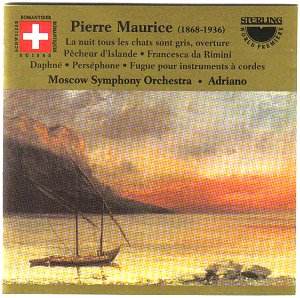The opening work is the witty, light-hearted
overture to Maurice’s comic opera La
nuit tous les chats sont gris
(All cats look the same in the dark).
This is music of French farce (two husbands
having to pay the price for falling
for each other’s wives). There is not
only droll material here but some little
depth for the music also points up the
underlying sadness of the situation.
Use is made of the well-known French
folksong, Au clair de la lune
Pierre Loti’s novel
Madam Chrysanthème inspired
the libretto of Puccini’s Madam Butterfly
but he is mainly known for his Pêcheur
d’Islande (1886) a tragic love story,
filmed at least five times, and set
in Brittany. Maurice’s musical impressions
on this tragedy are most affecting and
exquisitely beautiful. The opening movement,
‘On the Icelandic Sea’ depicts a ship
gently rocking on a becalmed sea in
rose-coloured sunset mists. The music
moves forward through these doldrums
in a long slow evocative crescendo as
desperation mounts but underneath there
is clearly a more human sub-context
for the sweetly romantic music speaks
of a mounting yearning. ‘The marriage
procession’ has black stormy music greeting
the couple as they emerge from church
with a grotesque folksong arrangement
taunting them – clearly this is a doomed
union. In ‘Declaration of love’ the
romantic music softly, tenderly, almost
shyly unfolds (lovely expressive string
writing here with the upper and lower
strings in counterpoint) as the setting
of glittering waves gently lapping the
sea shore is revealed. The final movement
‘Waiting on the shoreline’ has the heroine
looking out to sea waiting, wistfully,
the return of her man but he is lost
‘amidst a noisy storm, his marriage
with the sea was celebrated…’; all strongly
portrayed in Maurice’s music. This marvellous
work deserves to be far better known.
Although Tchaikovsky’s
Francesca da Rimini remains pre-eminent
for its sheer excitement and melodic
beauty, there is no denying the evocative
power and colour of Pierre Maurice’s
composition. Pacing and atmosphere are
in fact truer to the story and Maurice’s
effects and sometimes quirky orchestrations
often have the gritty, charred feeling
of fire and brimstone appropriate to
the nether regions. The tender, yearning
music for the forbidden romance impresses
too. As I listened, especially to the
early pages I was struck by a resemblance
to the style of Bernard Herrmann. This
association was confirmed in Adriano’s
notes.
Maurice’s captivating
Daphné Prelude contrasts
the delicacy of Daphné’s (daughter
of the river god, Ladon) floating melody
with the lusty bawdy music of the pursuing
Apollo.
The most substantial
work in this compilation is Maurice’s
two-movement Perséphone.
It allows the composer to present in
the opening section some imaginative
sylph-like dance music, almost impressionistic,
for the garlanded Perséphone
and her followers. This tranquil pastoral
scenario is invaded by the arrival of
Hades riding his black horse intent
on abducting the hapless daughter of
Demeter. Here darker, dramatic music
in the style of Richard Strauss predominates.
Part two opens with an evocation of
Hell where Perséphone has been
induced to wed Hades. The opening eerie,
high-pitched string figures with low
string ostinati evoking the desolation
of the nether regions and Perséphone’s
grief at not being able to see the light
and sunshine again, reminded me again
of Bernard Herrmann’s writing. Yielding
to her and her mother, Demeter’s entreaties,
Hades allows a six-month return to the
kingdom of light consequently Nature
celebrates a reawakening of spring.
And so the passing of the seasons in
and out of darkness is established.
All this is conveyed in arresting music
that vividly implies the conflict between
light and darkness and the ultimate
joyful victory of the season of regeneration.
In the march section of the second movement
I was reminded strongly of Max Steiner’s
Charge of the Light Brigade score,
in fact there is much in Maurice’s music
that would appeal to fans of romantic
music of Hollywood’s Golden Age.
Finally there is Maurice’s
five-minute Fugue for String
Orchestra. Classical in construction
and style, it is nevertheless no arid
academic exercise but a work with a
direct appeal to the emotions.
Adriano is to be congratulated
in unearthing more treasure-trove, an
album of vividly evocative and compelling
programme music that deserves to be
much better known
Ian Lace
see also reviews
by Michael
Cookson and Rob
Barnett
